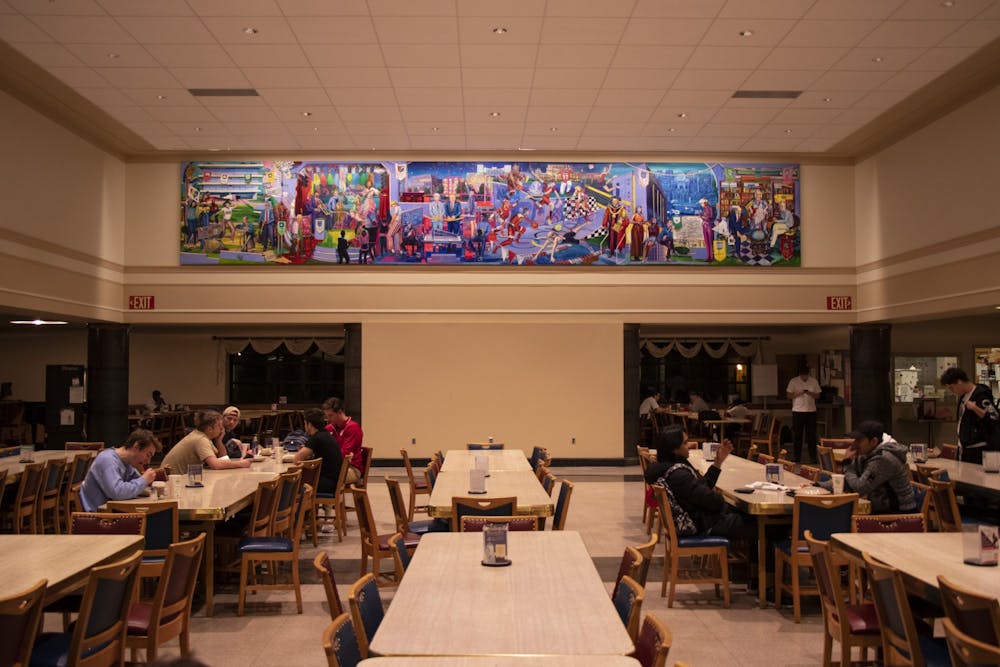IU recently revealed murals in Presidents Hall and Wright Quad dining hall to celebrate the Bicentennial. IU has three main mural collections around campus, and the recent additions are included. Here's a description of some of them.
Presidents Hall murals
IU commissioned two murals in Presidents Hall for the Bicentennial. The two represent part of IU’s motto, “Lux et Veritas,” or “Light and Truth.”
Bonnie Sklarski, the artist and a professor emerita in the Eskenazi School of Art, Architecture + Design, said it took about two-and-a-half years to complete the two murals.
In the “Light” mural, Sklarski focused on the sky, making it bigger and brighter to represent light. It has a cosmic aspect, she said. For this reason, Sklarski said she took inspiration from the Hubble Space Telescope images and included an image of the Earth at the bottom of the painting.
This mural also includes mythological figures that fit with the cosmic idea such as Apollo, Athena, Ares and Aphrodite, Sklarski said.
“I came up with mythological characters because I thought they would be good to show some of the spirits that people have,” Sklarski said.
In contrast, the “Truth” mural includes humans, starting with philosophers such as Socrates, Plato and Confucius.
A genderless and ageless personification of truth is also included, Sklarski said. The figure has a glowing ball in its hands and passes it to people in academic robes, which represent teachers. The teachers, in turn, try to pass the globe to a group of students, who are playing and not looking at the teachers.
Sklarski said she painted the students this way because they are new to the search for truth.
“Everything that is happening around them they are experiencing for the first time,” Sklarski said.
Wright Quad dining hall murals
The Wright Quad dining hall is home to a set of eight murals depicting IU history from its founding in 1820 to present day.
The most recent of the eight is the 1998-2020 mural that was commissioned in 2018 to celebrate IU’s Bicentennial. It took about a year and a half to complete, including planning and preparatory drawing and painting, said Caleb Weintraub, the artist and and associate professor of painting for the Eskenazi School of Art, Architecture + Design.
Weintraub used an online program called ZBrush to design the mural before painting it, he said. His goal was to make the mural modern and use technology to make the mural.
“My own painting practice, my own research is influenced by a combination of traditional and digital approaches,” Weintraub said. “I decided to do something similar with this.”
He painted figures from IU’s recent history such as opera singer Sylvia McNair, jazz professor and composer David Baker, Indiana Pacers player Victor Oladipo, Olympic swimmer Lilly King, professor and Nobel Prize recipient Elinor Ostrom and more recognizable students and faculty.
Weintraub included generic students based on the student population. One student is depicted holding an LGBTQ flag, one is wearing a “The future is female” shirt and another is holding a “There is no planet B” sign.
Weintraub received a Bicentennial medal for his work on the mural.
Late muralist Garo Antreasian painted the first six murals in Wright Quad dining hall in 1957. The murals represent IU from 1820 to 1957. According to the Visit Bloomington website, Antreasian was a visiting instructor at the time. It was the first public art project that used acrylic paint, Weintraub said.
After Antreasian, IU alumnus Mark Flickinger painted the 1958 to 1998 mural.
The mural includes figures such as former IU basketball coach Bob Knight, Olympic swimmer Mark Spitz and violinist and former faculty member Joshua Bell and opera singer Sylvia McNair.
Flickinger said he was unaware IU had commissioned another mural for the Wright Quad dining hall until his interview with the Indiana Daily Student onTuesday. Weintraub's mural is on the opposite side of the dining hall across from Flickinger's. Flickinger looked up a picture of Weintraub's mural online. It is well-balanced and has wonderful color, he said.
“If Indiana does a mural every 20 years, that’d be fantastic,” Flickinger said.
Thomas Hart Benton murals
Thomas Hart Benton, a muralist who lived in New York, was commissioned for a set of murals about Indiana history in 1933 for the Chicago World’s Fair, according to an Indiana government document on the creation and history of the murals. Col. Richard Lieber, the first director of Indiana's Department of Conservation, suggested the project and recommended Benton even though the muralist was not from Indiana nor lived in Indiana.
The project was made up of 22 panels that were moved to storage in the Indiana State Fairgrounds after the fair. Former IU president Herman B Wells asked then-Gov. Cliff Townsend for them in the 1930s.
In the early 1940s, 16 of the murals were placed in the IU Auditorium and the other six in Woodburn Hall and the IU Cinema building, formerly the Little Theatre.
One particular panel of the collection, located in Woodburn Hall Room 100, depicts Ku Klux Klan figures. This was controversial, and in 2017 a petition was created urging the university to remove it. IU never removed the murals. Removing them would cause irreparable damage to Room 100, Provost Lauren Robel said in a 2017 email. Instead, Room 100 is no longer being used as a classroom.






